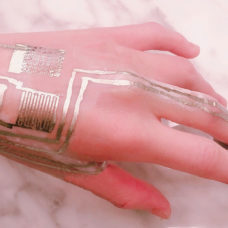Using the Kirigami technique, researchers designed thin sheets of materials that reshape in response to the environmental stimuli. The materials reconfigure into new two-dimensional and three-dimensional structures.
Kirigami is an art form that involves cutting and folding a piece of paper to create new shapes and structures.
To create an active Kirigami concept, the researchers from the University of North Carolina used a three-layered material. The two outer layers are not responsive to heat, but the middle polymer layer contracts in response to an increase in temperature.
The researchers control the shape and structure of the material in two ways: through-cuts and etchings. Through-cuts penetrate all three layers of the material and control its range of motion.
Etchings, on the other hand, penetrates only the outer layers and exposes the heat-responsive polymer. That way, it not only controls the angle and direction at which the material folds, but also how far it folds.
When the material folds, it opens the through-cuts, which in turn shifts the shape of the sheet into 2D or 3D designs.
Speaking about the project, co-author of the study, Jie Yin said:
“We can make a 2D template with the same pattern of through-cuts and use it to create many different 3D structures by making slight changes in the etching. This effectively makes the active kirigami sheets programmable.”
Making Robots From Self-Folding Kirigami Technique
As part of their proof of concept, the team developed a suite of thermoresponsive machines using the Kirigami technique. These include self-folding boxes and simple gripping devices.
Also, the researchers developed a soft robot with a Kirigami body and pneumatic legs. To switch the machine’s orientation, the team could reposition the leg, and change its direction of movement.
Although the team used a temperature-responsive polymer for their work, they pointed out that other stimuli-responsive polymer will be just as capable. For example, the researchers could use photoactive liquid crystals in place of temperature-responsive polymers.
“We’re excited to explore the potential range of applications for these programmable, active kirigami materials,” Yin says.



















Comments (0)
Most Recent